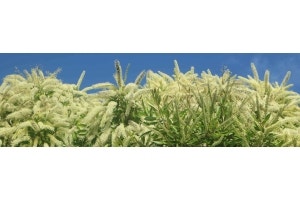
How Vines Climb
Vines and climbers cling on in four main ways - through aerial roots; by winding stems around a support; by coiled tendrils; and by hooks. You'll soon discover which one your vine uses...
Aerial Roots
These kind of vines attach themselves to their support through little aerial roots along the length of their stems, and little sticky pads at the side of their stems. Almost like a gecko attaches to the walls! These tiny roots are called 'adventitious roots', and are similar to the roots that many groundcovers produce along their stems. This method is used by ivy (Hedera), creeping fig (Ficus pumila), and virginia creeper (Parthenocissus) to cling onto flat surfaces - it's very effective as you can often see mature examples of these plants reach the roofline of buildings.

These rooted stems are easy to remove when young but very sticky on older woody stems. They will not damage a well-maintained building, but they can work their way into poorly maintained brickwork pointing and lift off old paint surfaces. So it's worth bearing that in mind if you let these vines establish and mature in place.
Winding Stems
This is the way many vines cling to their supports (and each other)- the growing tips gradually curl around until they have wrapped the supporting structure in their stem. You'll see this in runner beans and morning glory, pandorea and mandevilla, and wisteria. Vines that grow woody at the base can form twisted ropes in time - not all as thick as the superb tropical liana in the image here!
 Fun fact : the pretty purple flowering vine Wisteria climbs like this, in two different ways - Japanese wisteria (Wisteria japonica) twines clockwise, and Chinese wisteria (Wisteria sinensis) twines anti-clockwise...
Fun fact : the pretty purple flowering vine Wisteria climbs like this, in two different ways - Japanese wisteria (Wisteria japonica) twines clockwise, and Chinese wisteria (Wisteria sinensis) twines anti-clockwise...
Tendrils
Fast-growing herbaceous vines often climb by tightly coiled spiralling tendrils, emerging from leaf nodes (where the leaf joins the stem) or produced from the growing tips. You'll see this in grape vines, passionflowers, and sweet peas. Gloriosa lilies even produce tendrils at their leaf tips. This method of clinging is due to something called 'thigmotropism'; when the tendril touches something, it starts to grow faster on the side away from the touched surface and slower on the touching surface, creating a curl.
 Some plants like clematis and pothos have developed a mash-up of stem winding and tendril clinging - they secure themselves on by winding their leaf-stalks around a support. The main stem continues growing straight, while the folded leaf-stalks help it stay upright and attached.
Some plants like clematis and pothos have developed a mash-up of stem winding and tendril clinging - they secure themselves on by winding their leaf-stalks around a support. The main stem continues growing straight, while the folded leaf-stalks help it stay upright and attached.
Hooking On
Climbing roses, bougainvillea , and brambles like loganberry and boysenberry, use a method of hooking on with their thorns until the lower stems become woody and strong enough to support the plant's weight.Some scramblers like native hardenbergia climb by hooking their leaf joints over supporting plants; it's not as adhesive a method, but very effective over short heights.
 Fun fact : Australian rainforests have some of the most extreme examples of this technique in Calamus plants, such as lawyer vines and hairy mary - those fans of thorns snag handy tree trunks and unwary passers-by with equal enthusiasm!
Fun fact : Australian rainforests have some of the most extreme examples of this technique in Calamus plants, such as lawyer vines and hairy mary - those fans of thorns snag handy tree trunks and unwary passers-by with equal enthusiasm! Calamus images: Tatters
Training Your Climbing Plants
To create fast-growing privacy screens and vertical green gardens, give your climbing plants some support to cling on to. If you don't need anything permanent, you can train climbers along a fence line using vine eyes, over a chicken wire mesh fence, or threaded on sturdy wires. Annual plants like beans, tomatoes, and sweet peas can climb up a wigwam of bamboo canes, which are fast to install, or even use a simple tension string for support.

Fun fact : hop vines grown for beer production are trained up long strings; stiff hairs along their stems act like tiny hooks to anchor them on. The angle of the strings maximises light to the plant and minimises the effort the plant needs to grow.
 More permanent plantings can use sturdy posts, pergolas, arbours, and tree trunks to connect to. If you plant fast-growing climbers, better make sure the supports are sturdily constructed! Redirect and gently tie in any new shoots every couple of weeks to get maximum screening coverage and an organised growth pattern, or let the plants find their own way. Your climbing plants will grab hold and start growing in their own ways - giving you a flowery foliage-filled garden, fast!
More permanent plantings can use sturdy posts, pergolas, arbours, and tree trunks to connect to. If you plant fast-growing climbers, better make sure the supports are sturdily constructed! Redirect and gently tie in any new shoots every couple of weeks to get maximum screening coverage and an organised growth pattern, or let the plants find their own way. Your climbing plants will grab hold and start growing in their own ways - giving you a flowery foliage-filled garden, fast!

































